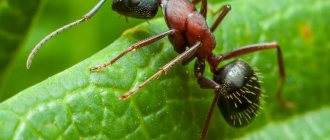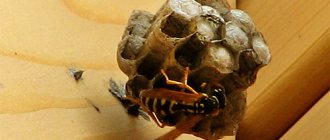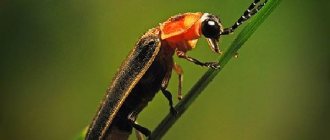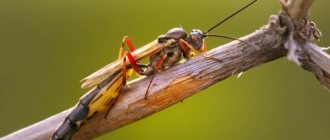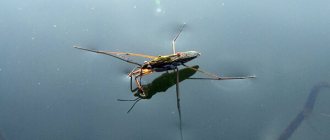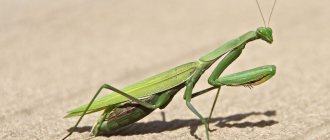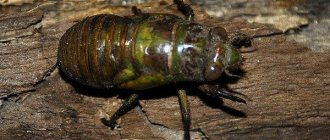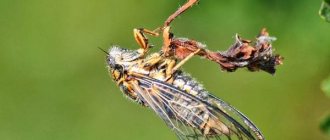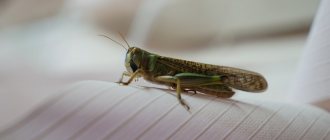Ants have become widespread throughout the planet. They live on all continents, excluding Antarctica, belonging to insects characterized by living together in colonies with a strict hierarchy.
Species of ants living in populated areas can partially crawl into residential buildings, causing their “legal” inhabitants many problems. When a person is faced with a similar problem, the best solution is to call a specialist from a professional company who will thoroughly treat the premises against insects.
However, many will be interested in information about what an ant looks like or other questions related to these hard-working insects that are useful in some ways, but on the other hand, are harmful to humans.
Description of ants
In fact, to the question of what a red ant or ant of other species looks like, you can give an answer that describes all types of insects at once, because they all have common features in their structure.
The body of this insect includes three main parts - the head, chest and abdomen, connected by a thin waist. All of them are covered with a strong chitinous shell. The eyes have a large number of lenses that do not transmit a clear image, but allow one to clearly distinguish movements.
Insects have six thin legs with sharp claws that allow them to move along vertical surfaces. On the head there are segmented antennae that act as organs of touch. They allow ants to capture air currents, various odors, and pulsations in the soil. To protect themselves from enemies, ants have powerful mandibles and special glands that produce poison (acid).
Features and habitat of the ant
Ants are among the most familiar insects to humans, which can be found in the forest, at home and on the street. They belong to the Hymenoptera family, are unique and extremely interesting to observe. Insects build dwellings, which are commonly called anthills.
The body of an ordinary red forest ant is clearly divided into three parts, from which the large head stands out. The main eyes have a complex structure. In addition to them, the insect has three additional eyes, which are designed to determine the level of light.
The antennae are a sensitive organ of touch, perceiving subtle vibrations, temperature and direction of air flows, and are capable of performing chemical analyzes of substances. The upper jaw is significantly developed, and the lower jaw helps in construction work and carrying food.
The paws have claws that give the ants the ability to easily climb vertically. Worker ants are underdeveloped females and do not have wings, unlike males and a queen, which later discards them. The ants have a sting on their abdomen that is used for nutrition and protection.
When bite insects, they release acid, which is a type of poison. In small quantities, the substance is not dangerous to the human body, but painful phenomena may occur: redness of the skin, swelling, itching. Wasps are insects so similar to ants that many scientists are inclined to consider them their closest relatives.
species of ant insects on earth, which is about half of all living creatures on the planet. They have settled all over the world and are found even in Antarctica.
Ant species come in different sizes (from one to fifty millimeters); colors: red, black, glossy, matte, less often green. Each type of ant differs in external characteristics, behavior, and also a certain way of life.
Of the varieties of ants, more than a hundred have settled in our country. In addition to forest ants, the most famous of them are termites, pharaoh ants, meadow ants, leaf cutters and house ants.
Red or fire ants are a dangerous species. Adults measure up to four millimeters, have pin-tipped antennae on their heads, and have a poisonous sting.
There are flying species of ant insects , the wings of which, unlike ordinary varieties, are a characteristic feature of all representatives, regardless of gender.
What does the ant queen look like?
An interesting question is, what does the queen of house ants look like? The queen (female, queen) is the most important individual of the family, being the basis for the existence of most anthills.
The ant queen is busy feeding and laying eggs, creating the basis of a future society. However, until this moment, the young queen leaves her native nest to fly to meet the male and mate. Subsequently, she loses her wings (often chewing them off on her own or with the help of worker ants) and seeks shelter to start a family.
What do they eat?
What does an ant eat? The diet of ants depends greatly on their habitat and can include food of both animal and plant origin. Some species, such as tiny Amazon ants, have learned to create entire traps to hunt insects many times their own size. To do this, they cut off the hair fibers of the house plant, after which they weave a cocoon from it. Many small holes are made in the walls. After this, the cocoon is placed outside the cavity of the house plant, and hundreds of working individuals hide in it. They stick their heads into the holes and wait like traps. As soon as prey falls into the trap, they will grab it by the paws, mandibles, and antennae and hold it until reinforcements arrive, which will pin the victim to the point of paralysis. The ants will then cut up the body and gradually transport it home. No less interesting is the fact that during construction the ants use “composite” material. To increase the strength of the trap, they coat the walls of the cocoon with a special moldy fungus. It acts like glue - it connects hairs and fibers, making the entire structure stronger.
For ordinary ants living in Europe, nutrition is much simpler. They obtain the main share of carbohydrates by absorbing honeydew and honeydew secreted by aphids. At the same time, foraging ants often carry honeydew in their crops to later feed oncoming ants, since each individual needs to feed several times a day.
Seeds, juices of various plants, and in some cases nuts and roots can also serve as a source of food. Some species grow special colonies of mushrooms. A significant portion of the diet is played by sedentary insect species, such as caterpillars. In general, they can be called omnivores.
Harvester ants feed on dry seeds, dried fruits and grain crops. They can store up to a kilogram of raw materials, which allows the colony to survive any winter. The Dracula ant consumes the juices that its larvae secrete and feeds them with insects. Leaf-cutter ants have a more interesting system. They use their jaws to cut off pieces of leaves, after which they bring them to the anthill and chew them. Subsequently, a fungus begins to grow on these leaves, which the ants eat.
Often, such mushroom “plantations” are infected with an aggressive ascomycete fungus. He is capable of turning the entire plantation into an inedible mass in a short time. Because of this, the ants were able to develop a simple and effective method of defense - a natural antibiotic, namely the actinomycete bacteria that produce it. These bacteria, like the cultivated fungus itself, are part of the obligatory part of the things that the newly-made queen takes when leaving her native anthill. Even if the parasite gets used to the antibiotic, the ants will simply breed a new strain.
How do ants reproduce?
As the weather warms up, young males and females grow wings to begin their mating flight. Soon after mating, which often takes place right in the air, most of the males die, and the females go to look for a suitable place for a new colony. Having found a suitable one, the female makes a small underground chamber, where she lays the first eggs. They will develop for about a week, after which they hatch into larvae, which the queen feeds with secretions from the salivary glands. She herself does not eat anything during this period, using up her fat reserves. The wing falls off on its own.
After another two weeks, pupation begins and the first adults appear. From this moment on, they begin to take care of all aspects of the development of the colony, while at the same time beginning to explore the world around them.
How big is the queen ant?
The main feature is the size of the ant queen. It is almost always much larger than workers, with a larger head and a huge (compared to the rest) abdomen. In some cases, the queen and worker ants may appear to be different species due to significant size differences.
So, what does the queen of house ants look like? This is a large ant, reaching a length of up to 5–6 mm. Moreover, only the large round abdomen, intended for laying eggs, can reach 3–4 mm. The female is usually yellow-brown in color, but her abdomen is much darker than her head.
Ant reproduction and lifespan
There may be one or more queens in the family of these insects. Their mating flight occurs only once, and the collected sperm supply is enough for the rest of their life. After the ritual, the female sheds her wings and becomes the queen. Next, the uterus searches for a suitable place to lay eggs.
In forest ants they are quite large in size, have a milky white color with a transparent shell and an elongated shape. Eggs fertilized by the queen produce females; the rest produce males, who live only a few weeks before mating.
Ant larvae go through four stages of development and are worm-like, almost motionless and fed by worker ants. Subsequently, they produce yellow or white egg-shaped pupae.
What caste an individual will emerge from depends entirely on feeding. The presence of reproduction methods for some species of ants is impressive; for example, females can appear through asexual reproduction.
The lifespan of worker ants reaches up to three years. The lifespan of a queen, from the point of view of insects, is enormous and sometimes reaches twenty years. Tropical ants are active year-round, but individuals living in harsher regions remain dormant in winter. Most often, larvae enter diapause, and adults simply reduce activity.
Why do ants fly?
Ants have wings on individuals who reproduce—females (queens, queens) and males. At a certain time, they leave the anthill and mate in the air. After this, the male dies, and the fertilized female goes as far as possible from her native nest to find a convenient place to organize a new colony.
Flying ants are not a separate species. However, their wings remain for a very short time. After all, the males quickly die, and the females chew off the wings that interfere with movement on the ground after they find a suitable place for their anthill.
Character and lifestyle of an ant
The life of ant insects actively influences biogenesis due to their abundance. They are unique in their type of nutrition, lifestyle and influence on organisms, plants and animals.
With their vital activity, the construction and reconstruction of anthills, they loosen the soil and help plants by feeding their roots with moisture and air. Their nests create ideal conditions for the development of bacteria that enrich the soil with useful substances and microelements.
Ant excrement serves as fertilizer. Various herbs grow vigorously near their homes. Forest insects ants contribute to the growth of oaks, pines and other trees.
Ants are hard-working insects and have extreme efficiency. They can lift loads weighing twenty times their own and move great distances. Ants are social insects .
This means that their social structure resembles that of humans. Tropical ants are distinguished by a particularly diverse caste. They have a queen, soldiers, workers and slaves.
Ants and other insects , such as wasps and bees, are unable to live without their community, and die apart from their own kind. An anthill is a single organism, each individual clan of which cannot exist without the others. Each caste in this hierarchy performs a specific function.
A substance secreted by ants, called “ant alcohol,” serves as a component for medicines for many diseases. Among them are bronchial asthma, diabetes mellitus, rheumatism, tuberculosis and many others. This substance is also used to prevent hair loss.
What size is an ant?
The size of ants varies depending on the type of insect. Thus, the body length of forest ants is red-brown in color with a black abdomen and ranges from 7–14 millimeters.
And what size are the ants that love to occupy human habitation? The pharaoh (house) ant is one of the smallest representatives of the family. Their working individuals do not grow more than 2 millimeters, and the body length of males is usually no more than 3–3.5 mm.
Fact
Such insects cause harm from a practical and aesthetic point of view. They spread infections, spoil food, promote the development of mold and an increase in pathogenic microbes. Therefore, the fight against them must begin immediately and be carried out in the most effective ways.
External structure
Ants are insects that are considered one of the most famous and numerous in the world. Ant size and weight vary depending on the species. Body length can range from 1 to 50 mm. And more often than not, the largest ants are also the most dangerous in the world. Moreover, females are usually much larger than males. Body color depends on the species.
The anatomy of an ant is quite complex. The body of the murash is covered with a chitinous shell. This kind of skeleton not only supports, but also protects the baby. The description of the appearance of different representatives is almost similar. Head, chest and abdomen - this is the structure of the ant. A photo of the ant can be seen below.
Head
The head of an ant is usually large in size; for each individual species it differs in a certain structure. It has powerful mandibles. With them, workers carry food, blades of grass and twigs used for building nests. Mandibles also help insects defend themselves.
Eyes
Not everyone can answer the question of how many eyes an ant has. The insect's eyes have a complex faceted structure. In addition to the paired ones, there are 3 more ocelli. With them, tiny creatures determine the level of illumination and the plane of polarization of the light flux.
Mouth
The mouthparts of an ant are of the gnawing type. It includes the jaws, which are also called mandibles or mandibles, the upper lip (labrum) and the lower lip (labium). The mandibles can be large or not very large, excessively sharp or completely blunt. They are also overlapping and interlocking. Thanks to this feature of ants, mandibles can chew food even with their mouths closed.
- 37 facts about cheetahs
- Scolopendra
- 32 facts about tigers
- Weasel
- Whale shark
- 34 facts about raccoons
The organ of taste for goosebumps is the tongue located on the lower lip. Insects also use it to clean their bodies.
Mustache
The sensory organ of insects is the geniculate antennae. They help ants detect odors, detect vibrations and vibrations in the air. In addition, insects use this organ to receive and transmit signals during communication with their relatives.
Abdomen
The abdomen of ants is stalk-shaped (the stalk is formed by one or two rings). There may be a vertical growth or notches on it. Some varieties of ants have a sting at the end of their abdomen, which serves as a tool for hunting and their defense. Thanks to it, insects secrete acid - a special substance that paralyzes the enemy.
Paws
The ant has 3 pairs of well-developed legs, each of which is located on a separate thoracic segment and ends in a hooked claw. Thanks to this feature, the ant’s movements can occur not only on horizontal, but also on vertical surfaces. A close-up photo of the ant is shown below.
The method of their movement depends on the structural features of the insects' paws. Not all ants move on foot; some species have the ability to jump. There are also gliding insects and runner ants, red fire ants are able to form bridges over water barriers.
The ant's legs serve more than just movement. So, with its front legs, equipped with special brushes, the insect takes care of its antennae. Spurs located on the hind legs are used for attack and defense. And the presence of small serrations on all legs allows insects to move even along steep, smooth surfaces. An example of this is pharaoh ants, which can run quickly on glass.
What is the biggest ant?
The largest ant in the world is a member of the species Dinoponera gigantea (giant ant). These black insects live exclusively in the humid forests and savannas of South America. Their size reaches 33 millimeters.
However, the size of the largest ant in history reached seven centimeters. It was a female of the extinct species Titanomyrma lubei, found in Wyoming, America. At the same time, its wingspan reached 15 centimeters. This group of ants lived in North America about 50 million years ago. This queen, the largest ant ever found, is comparable in size to a hummingbird.
The largest ants in Russia are representatives of red-breasted carpenter ants, the size of females of which can reach 20 mm in length.
Internal structure
The internal organs of the ant, which are located in the abdomen, are also unique in their own way. So the esophagus ends not with the stomach, but with the so-called goiter. Insects use it to collect food. If it is necessary to treat its relative, the ant regurgitates some of the food from this cache. This is especially true for honey ants, which are also called barrel ants.
Nervous system
The insect nervous system includes several interconnected ganglia. Thus, the suprapharyngeal ganglion, which acts as a brain, is responsible for the thinking and behavior of insects. It is much larger in relation to the body. The working ant has a particularly large brain; in females it is slightly smaller, and in males it is the smallest.
Circulatory system
The blood of ants is a clear liquid - hemolymph. It is driven throughout the body by the spinal vessel – the heart. It is a muscular tube that runs along the entire back.
Respiratory system
Respiratory system of tracheal type. The trachea opens outward through stigmas (spiracles), which are located on each abdominal segment (on a stalk at the base of the scale).
Origin of the species and description
Photo: Pharaoh Ant
These reddish babies were first discovered in the tombs of the pharaohs. They were located on mummies, where they climbed in search of food. After their capture, they were handed over for description to the Swede Carl Linnaeus, a naturalist, who described this insect in 1758, calling it the pharaoh ant. He put forward the version that Egypt and the neighboring territories of North Africa are his homeland. This animal has 128 species of close relatives, of which 75 are native to East Africa.
Video: Pharaoh ant
In Europe, the pharaoh ant was found in 1828 in London, where an illegal migrant was comfortably located in dwellings under fireplace slabs. By 1862, the ants reached Russia and were discovered in Kazan. In 1863 they were caught in Austria. Somewhere around this time, insects were found in American harbors. Gradually, pharaoh ants from port cities penetrated deeper into the continents. The creation came to Moscow in 1889.
In Australia, this species has been particularly successful. This fact is especially curious due to the presence of a very aggressive ant family, Iridomyrmex. These ants are able to quickly find food sources and prevent other ant species from accessing them. However, Monomorium species, despite their relatively dormant nature and small size, are able to thrive even in areas where Iridomyrmex dominates.
This success can be attributed to their efficient foraging strategy and proper use of poisonous alkaloids. With these two types of behavior, Monomorium species can quickly monopolize and defend a food source.
The role of ants in nature
useless living creatures in nature . None at all. Ants bring benefits than many of the larger animals. Part of this enormous benefit can be realized due to the fact that the density of ants is approximately 17-20% of the total mass of all insects on our planet. So, here are the main benefits of six-legged insects for the forest .
- Orderlies. Anthills are “based” in fallen leaves and tree bark. The activity of insects greatly accelerates the decomposition process, which reduces the number of harmful bacteria and small parasites that can cause harm to other forest inhabitants.
- Once again, orderlies . Ants are predators . Violent and omnivorous. A large colony of insects can kill a bird of decent size. By destroying small pests, ants make it possible for a large number of plants to develop, and at the same time make the existence of larger living creatures easier. Interestingly, ants destroy about 20 times more other insects than birds!
- Pollinators. Hard workers do not disdain plant seeds. But on the way to the anthill, some of them are lost. As a result, new plants grow along the ants' routes. In terms of efficiency, they, of course, cannot compare with bees, but they perform their role well.
- Leavening agents. An anthill is a collection of a huge number of tunnels underground. The loosening of the soil reaches such proportions that even some exotic plants can grow in the area of the ant’s home.
- A source of vitamins or “natural medicine” in action . Although ants are predators, they often become prey themselves, mostly of birds. These insects are so nutritious that the average bird could, in theory, eat only them. In addition, formic acid acts as a septic tank. By pushing ants under their feathers, birds get rid of parasites.
Now do you understand why the destruction of anthills is prohibited by law ? If there are suddenly no more ants, or at least their concentration decreases, then the world will never be the same.
Video
How do ants prepare for winter?
To ensure sufficient nutrition and a quiet winter, they perform a large amount of work. First of all, the ants prepare a sufficient amount of food; for this, workers collect caterpillars, beetles, bedbugs and other garden insects that live in their area. A certain part is used to feed the larvae, and the rest is stored in special chambers suitable for wintering. This way they won’t have to leave their “rooms” and let the cold into the anthill. The harvested diet also includes various parts of plants, their fruits and seeds. In addition, they bring live aphids into underground rooms, and the ants happily eat their secretions.
Preparation is not complete without insulating the home. Working ants build a kind of hill (dome) over their homes, which provides warmth during harsh weather conditions. In red forest ants, such a mound reaches a width of more than 1 meter and a height of 50 cm. This heap contains passages and chambers. The collected loose material prevents the cold from penetrating into the underground rooms. They also prepare compartments for wintering, insulating them and storing food.
Adult insects take care of the future generation. To prevent the larvae from dying, they are transferred to chambers where it is warmer and the microclimate is satisfactory. There the air temperature will practically not fluctuate and drop to critical points.
With the onset of late autumn, little workaholics clog all the exits from their homes. The materials used are earth, clay, dry leaves, etc. In this way they ensure maximum warmth for their home.
If the upper layers freeze, the owners move supplies deeper, where the cold cannot reach and spoil the food.
Every year, before the air temperature drops, they expand their home and strive to make it even deeper.
Where does the pharaoh ant live?
Photo: Pharaoh ant in nature
Pharaoh ants are a tropical species that now thrive almost everywhere, even in temperate regions, provided buildings have central heating. The insect's habitat is not limited to cold climates. This ant is native to Egypt but has migrated to many regions of the globe. In the 20th century, he moved with things and products across all five continents on cars, ships, and planes.
The variety of habitats in which the pharaoh ant can live is amazing! Inhabits humid, warm and dark places. In northern climates, their nests are often found in households, namely the spaces in walls between studs and insulation that offer warm breeding sites relatively hidden from the human eye. The Pharoah ant is a big nuisance for home owners, whose numbers are difficult to control.
Pharaoh ants occupy ready-made cavities:
- cracks in the foundation and floor;
- house walls;
- space under the wallpaper;
- vases;
- boxes;
- folds in clothes;
- equipment, etc.
This species forms diffuse nests, i.e. one anthill occupies a large territory (within one household) in the form of several interconnected nests. Each nest contains several egg-laying females. Ants often migrate to nearby nests or create new ones when conditions deteriorate.
Interesting fact: Pharaoh ants were brought to Greenland, where these insects had never been found before. In 2013, a fully capable male of this species was found 2 km from the airport.
Pharaoh ants are difficult to control, since the disinfestation perimeter must cover the entire anthill. It is easier to prevent harmful insects from entering your home by sealing cracks and blocking their contact with food. Historically, kerosene was used for this purpose.
Now you know where the historical homeland of pharaoh ants is. Let's see what to feed these insects.
Where do house ants live?
In connection with the spread of ants that choose human housing as their habitat, the pressing question for many is where do house ants live?
They also live in nests (colonies, anthills), placing them in damp, dark and hard-to-reach places. They can be nooks in the bathroom or kitchen, or ants can live in electrical outlets or under tiles. In some cases, the ant nest is located in the interfloor ceilings, which significantly complicates the process of fighting the occupiers.
Natural enemies of the pharaoh ant
Photo: What a pharaoh ant looks like
Ant larvae grow and develop within 22 to 24 days, passing through several stages - growth phases, which end with molting. When the larvae are ready, they enter the pupal stage to undergo full metamorphosis, which is completed in 9-12 days. The pupal stage is the most vulnerable to the environment and predators. During evolution, ants have learned to bite and sting very sensitively.
What enemies pose a danger to these little ones:
- the Bears. They rake anthills with their paws and feast on larvae and adults.
- hedgehogs They are quite omnivorous animals, so they will have a snack near the anthill.
- frogs. These amphibians are also not averse to feasting on pharaoh ants.
- birds. Worker ants and queens that have left the anthill can get into the tenacious beaks of birds.
- moles, shrews. The prey is caught underground. While building a “tunnel”, larvae and adults can eat.
- lizards. They can catch prey anywhere.
- Antlion Patiently waits near the insect den.
The microscopic bacteria that these ants can carry are sometimes pathogenic, including Salmonella, Pseudomonas, Clostridium and Staphylococcus. Pharaoh ants can also irritate home owners by climbing onto food and unattended dishes. Therefore, the owners of housing in other institutions are trying to get rid of such proximity as quickly as possible.
